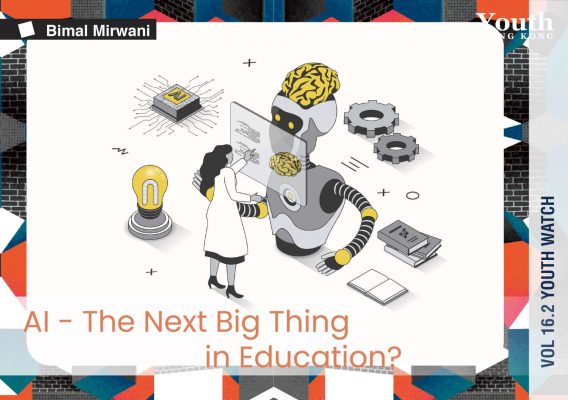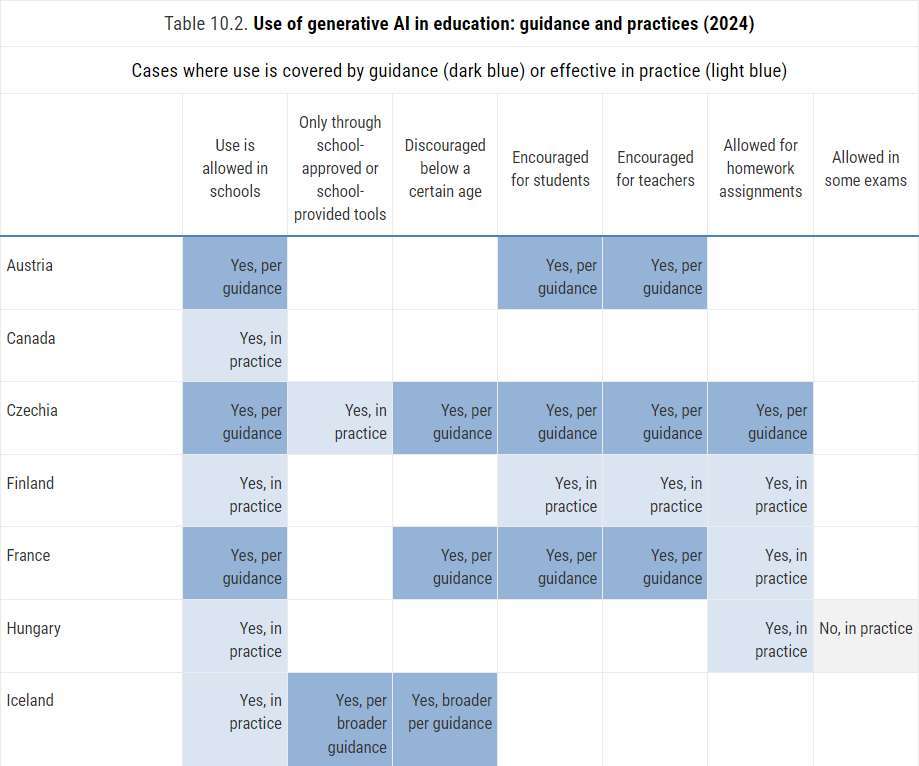//16.2 Youth Watch
AI – The Next Big Thing in Education?
by Bimal Mirwani
The future of education is not just about technological integration but also about creating an inclusive, ethical, and progressive ecosystem for all.
AI has become deeply integrated into all aspects of everyday life. Educational institutions around the world are championing the benefits of incorporating AI technologies into their curriculum and operations. Yet at the same time, they are facing the conundrum of ensuring AI doesn’t sully the overall teaching process and dismantle the pillars of education that have withstood the test of time.
The integration of AI in education has unearthed a plethora of complexities that need to be looked at. The global education community is navigating its way through the dynamic changes in the landscape, but ultimately, the key lies in striking a balance between harnessing the benefits of Generative AI and addressing the ethical and pedagogical implications.
A Clear Divide
The uneven distribution of digital resources in education poses a significant challenge, with developed nations pulling far ahead of countries lacking the necessary infrastructure and resources. Data platform Statista highlights that as of April 2024, only 67% of the world’s population had access to the internet, a prerequisite for leveraging AI tools in education. For example in countries like India, there has been a lack of access to general education in rural areas, let alone AI-related pedagogy.
Given the stark differences between developed and underdeveloped nations, it is strikingly clear that without adequate infrastructure and resources to provide equitable access, there is a real danger that AI could widen existing divides in education, as warned by the International Monetary Fund.

The uneven distribution of digital resources in education poses a significant challenge, with developed nations pulling far ahead of countries lacking the necessary infrastructure and resources.
Regulating and Teaching AI
Given the rapid advancement and widespread adoption of AI resources in education, countries are grappling with the challenge of regulating the use of AI in education. Some are taking proactive steps to address the issue by developing comprehensive guidelines and policies, while others are still in the infancy stages and are choosing to tread with caution.
The European Union (EU)
The EU is taking steps to integrate Generative AI in education as it seeks to take advantage of progressive technologies and the benefits they can bring to future generations. The EU has emphasised the need for safeguards and human oversight to ensure AI technology isn’t utilised for malicious purposes. As a result, the European Commission has established an expert group to draft guidelines for educators, authorities, and providers on the use of AI-generated digital education content. The main purpose is to form coherent national strategies and establish quality criteria in digital education.
Essentially, the EU is looking to strike the right balance between leveraging the opportunities of Generative AI in education and ensuring proper governance, ethical considerations, and human oversight to mitigate potential risks, such as copyright and biases.
Finland
Finland has embraced AI with a bold commitment to educate its citizens through free online AI coursework. The University of Helsinki and Finnish technology firm Reaktor jointly developed the 「Elements of AI」 online course to teach the basics of AI. The Finnish Center for Artificial Intelligence, aiming to provide AI literacy for all, also offers free AI courses on AI algorithms, ethics and its societal impact.
According to the 2023 survey data on the governmental use of AI for education, Finland was among seven countries that had either developed or were actively working on frameworks and training programmes to equip teachers with the necessary skills to leverage AI technologies in their classrooms.
United Kingdom
The United Kingdom is currently in the information gathering stage when it comes to the implementation of Generative AI in education. So far, the government has published a policy paper on 「A pro-innovation approach to AI regulation,」 which outlines the government’s perspective on regulating AI in the education sector.
In 2023, the government announced an additional investment of up to £2 million in Oak National Academy to create new AI teaching tools. The Department for Education then hosted a two-day hackathon, which brought together teachers, leaders, students and technology experts to experiment with AI.
United States
The United States currently lacks comprehensive federal policies and regulations for Generative AI in education. However, some states and school districts have started to take action.
Currently, 13 states are offering guidance for schools on Generative AI as of September 2023. Despite some states showing a level of proactiveness, a majority of them still don’t plan to provide such advice for the foreseeable future.
In a higher education setting, colleges and universities are largely deferring to faculty members to determine policies on Generative AI, indicating that the use of such technology in tertiary institutions is not set in stone.
While the current policies and regulations are vague at best, the United States Department of Education conducted a deep dive into the opportunities and risks for AI in education. In a report titled 「Artificial Intelligence and the Future of Teaching and Learning」 released in 2023, the department emphasises keeping humans in control, addressing contextual factors that influence learning, ensuring AI enhances rather than replaces human judgement, and mitigating risks related to data privacy, bias, transparency, and accountability.
The report recommends focusing R&D efforts on addressing contextual factors in AI-enabled learning systems, aligning AI adoption with educational priorities based on student needs, and developing education-specific guidelines and regulations for the trustworthy and equitable implementation of AI in edtech.
Japan
Japan has already gotten the ball rolling when it comes to regulating Generative AI in education. In 2023, the country introduced its Temporary Guidelines for the Use of Generative AI in Primary and Secondary Education, as reported by the OECD. The guidelines recommend limited and supervised use of AI, particularly for elementary students, to assess its impact through controlled trials in selected schools. Passing off AI-assisted school work as one’s own will be deemed cheating in the guidelines.
Furthermore, the guidelines promote the use of AI in English learning and encourage its integration into group activities to enhance learning. The education ministry also stressed the importance of AI literacy among teachers. The guidelines encourage teachers to use fake information generated by AI as teaching materials for students so they can learn how to fact-check. They also promote the use of AI tools to reduce teachers’ workloads by streamlining administrative tasks and improving their teaching practices.
Singapore
In Singapore, the government has been regulating the development and application of AI systems since 2018 through voluntary frameworks and guidelines. The Ministry of Communications and Information has engaged stakeholders on the responsible use of AI. The ministry has published a discussion paper through the Personal Data Protection Commission and has set up the Advisory Council on the Ethical Use of AI and Data.
In the spectrum of education, AI Singapore, supported by Singapore’s Ministry of Education, has launched the 「AI Student Outreach Programme」 which aims to promote AI literacy and proficiency among students. There are initiatives like 「AI Singapore Goes to School」 to introduce students to AI basics and applications like ChatGPT through 2-hour learning sessions and programmes for teachers to improve their AI literacy.
China
China is taking a vigilant approach to integrating Generative AI into education. While some schools are experimenting with AI tools, a majority of college students in China have utilised AI tools produced both globally and locally, such as Baidu’s Ernie Bot.
In 2018, China introduced AI education for K-12 students, with the aim of better promoting the development of AI education. One year later, China announced plans to push for AI courses on programming, machine learning, big data application, image recognition and algorithms to be offered at primary and secondary schools.
China’s Ministry of Education (MOE) in 2024 announced a list of 184 primary and secondary schools selected as AI education bases, with the aim of better promoting the development of AI education.
Hong Kong, China
The Hong Kong Education Bureau has promoted STEAM (Science, Technology, Engineering, the Arts and Mathematics) education in primary and secondary schools by incorporating I&T learning elements.
In 2023, the education bureau launched the “Enriched Module on Coding Education for Upper Primary Level” and “Module on Artificial Intelligence for Junior Secondary Level.” In the circular memorandum, primary schools are advised to incorporate 10 to 14 hours of enriched coding education for all upper primary students at each level every year. Secondary schools are advised to allocate 10 to 14 hours of AI learning at the junior secondary level to teach the AI curriculum module.
In higher education, several universities have launched initiatives to ensure the technologies available are used wisely. On a wider scale, Microsoft is collaborating with eight universities funded by the University Grants Committee of Hong Kong to integrate Generative AI models across academic, research and operational domains. This includes using Generative AI for course design, student engagement, research assistance, and campus-wide virtual assistance.
Conclusion
As the world grapples with the rapid advancements in AI, the education sector stands at a pivotal crossroads. Generative AI, with its profound capabilities to create content, simulate complex scenarios, and personalise learning experiences, is being integrated into educational frameworks across the globe.
However, the adoption of this technology in education has revealed a spectrum of approaches, reflecting diverse educational policies, cultural values, and readiness levels. Ultimately, the future of education is not just about technological integration but also about creating an inclusive, ethical, and progressive ecosystem for all. ■
References:
- How governments in developing countries can close the digital divide
- Statista: Number of internet and social media users worldwide as of April 2024
- How Artificial Intelligence Could Widen the Gap Between Rich and Poor Nations
- European School Education Platform: Digital education content generated or assisted by AI
- Emerging governance of generative AI in education
- Year in review: Artificial Intelligence Law in France
- The UK Department of Education: Generative AI in education
- New research paves way for Artificial Intelligence in education
- UK Parliament Post: Use of artificial intelligence in education delivery and assessment
- China Daily: Experts call for appropriate use of AI tools
- At The University of Hong Kong, a full embrace of generative AI shakes up academia
- Transforming the future of education: Microsoft revolutionizes Hong Kong’s teaching and learning models with Generative AI technology
- EDUCATION BUREAU CIRCULAR MEMORANDUM NO. 109 /2023
- Artificial Intelligence Curriculum for Junior Secondary Students in Hong Kong – Teaching and Learning Pack
- AI is already disrupting education, but only 13 states are offering guidance for schools
- U.S. Department of Education Shares Insights and Recommendations for Artificial Intelligence
- UNESCO: Guidance for generative AI in education and research
- Japan publishes guidelines allowing limited use of AI in schools
- IPS Working Papers No. 52 REGULATING ARTIFICIAL INTELLIGENCE: MAXIMISING BENEFITS AND MINIMISING HARMS



